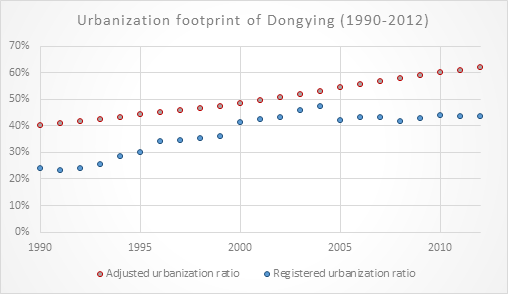Dongying urbanization footprint – Trend and revision
Lili Jia, Center for Development Research, University of Bonn
Urbanization can be defined as the share of registered non-agricultural population of the total population. In the past 22 years, this number has increased from 24% to 43% (Dongying statistical yearbook, 1990-2012). However, the citizenship registration is far lagged behind the true urban residential status leading to an underestimation of urbanization. For example, there are plenty of non-citizens working and living in the city but are not counted in the statistics of urban population; a number of rural laborers migrate to the city but did not change their citizenships due to various reasons. In this manner, the national population surveys reported higher urbanization ratios than the registered urbanization ratios in the years 1990, 2000 and 2010. Nevertheless, the definition of urban population has changed over time and the urbanization ratios between the national surveys need to be adjusted in order to smooth the trend (Chan and Hu, 2003). Both adjusted and registered urbanization ratios are presented in the following figure and it shows that the adjusted urbanization ratios correct the underestimations of registered urbanization ratios significantly.

Source: The adjusted urbanization ratios in 1990, 2000, 2010, 2011 are adapted from http://dy.house.sina.com.cn/scan/2012-12-27/144031180.shtml and the other years are calculated according to Chan and Hu (2003). The registered urbanization ratios are calculated according to Dongying Statistical Yearbook (1990-2012)
Reference: Chan KW, Hu Y (2003) Urbanization in China in the 1990s: New Definition, Different Series, and Revised Trends. The China Review 3( 2): 49-71.




